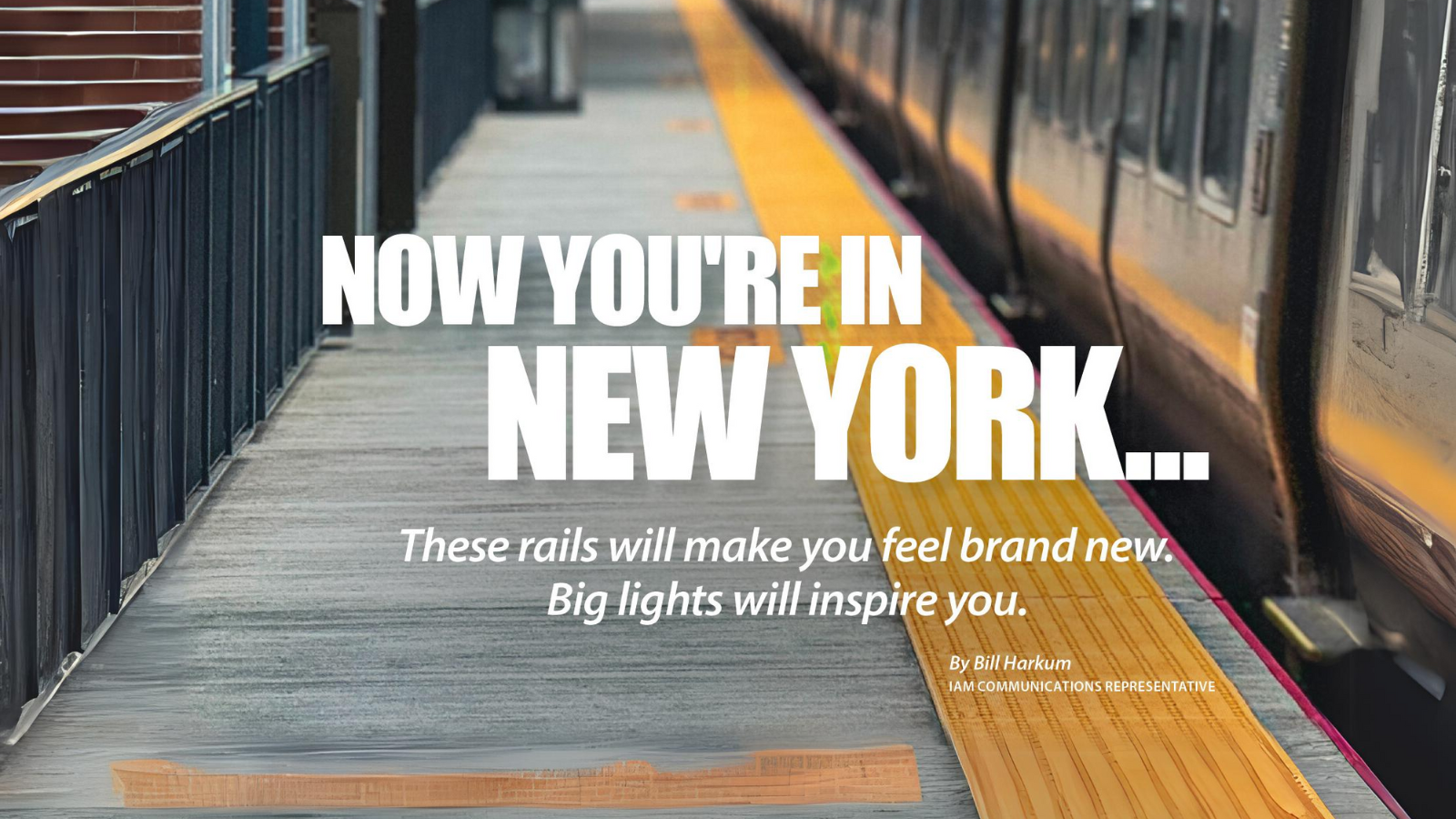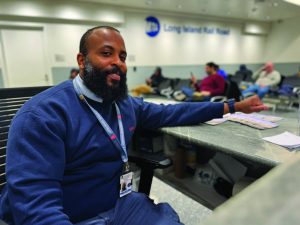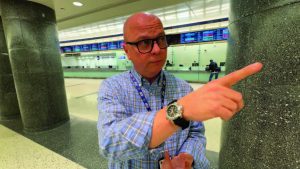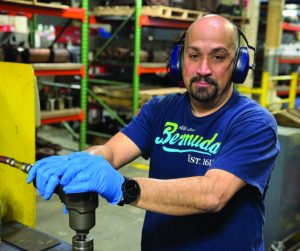

This article was featured in the IAM Summer 2024 Journal and written by IAM Communications Representative Bill Harkum.
“Good morning! This is a Grand Central Madison train. Next stop, Jamaica.”
A Long Island Rail Road (LIRR) train is racing toward Manhattan. There isn’t any confusion that Jamaica, Queens is the next stop, not the warm sand beaches on the Caribbean island.
Each year, roughly 168 million riders move along the commuter rail systems in and around the New York City area. The three prime commuter rail systems–Long Island Railroad (LIRR); Metro North, and New Jersey Transit–make up the core of several different rail carriers around the largest city in the U.S.
“IAM Rail Division members in IAM District 19 and TCU/IAM are proud to move America each and every day,” said Josh Hartford, IAM Special Assistant to the International President for the IAM Rail Division. “In the city that never sleeps, it is our members who keep New York running on the rails.”
David Proffitt is an information clerk at the brand new Grand Central Madison (GCM) Terminal in Midtown East.

David Proffitt, Information
Clerk, TCU/IAM Local 177, Grand Central, Madison, NY.
“People love this station,” said Proffitt, a Transportation Communications Union (TCU/IAM) Local 177 member. “People commute in from upstate New York or Connecticut. It’s an easier transition for them to get to where they need to go. And it’s beautiful.”
Beautiful is just one of several adjectives used to describe the largest railroad station to open in the United States since 1950.
“As a native New Yorker, it’s always an honor to see our members at work,” said TCU/IAM National President Artie Maratea. “Through Manhattan, the five boroughs and across the nation, our union is keeping our country moving.”
With state-of-the art lighting and track platforms, riders immediately recognize that Grand Central Madison is an investment in making American infrastructure world class again. But it’s a huge operation.
“It’s massive. It’s successful. And it’s something people have been looking forward to for a long time,” said Jeff Pacini, a more than 30-year TCU/IAM Local 177 member who used to serve as a local chairman. “This build out was close to 15 years. It’s only been open a year.”
Pacini is currently the acting terminal manager at Grand Central Madison and says ticket numbers show the station carries more passengers daily than Chicago’s entire commuter rail system. This station on Manhattan’s east side has relieved nearly 40% of the daily train traffic that once ran to Penn Station on Manhattan’s west side. That venerable location has also welcomed the Moynihan Train Hall at Penn Station as another modern upgrade to New York City’s rail infrastructure.

Jeff Pacini, Acting Terminal Manager, Grand Central, Madison, TCU/IAM Local 177.
The new Grand Central Madison terminal, built next to and below the storied Grand Central Station on Manhattan’s Upper East Side, sits 17 stories below street level. A 150-foot-long escalator appears like a sculpture that carries riders to the traditional sections of the station for the New York Subway, also run by MTA of New York, and other commuter rail access. And that’s a lot to clean.
“It’s a massive undertaking. Dealing with tunnels, brake dust, and dirt. It requires constant cleaning 24/7,” said five-year TCU/IAM Local 90 member Thomas Lynch.
Cleaning includes a station shut down from 1 a.m. to 6 a.m. to do the work that would interrupt movement in the station.
“It’s stainless steel and terrazzo floors,” said Lynch. “Nobody else has to deal with that 17 stories below ground.”
“I’d rather [riders] not know and just see that it’s spotless because we’re behind the scenes,” said six-year TCU/IAM Local 90 member Joseph Urrego.

Clockwise: Ivan Torres, LIRR, Local 754. Bill Kunath, NJ Transit, Local 1041. Matthew Kalwiss, LIRR, Local 754.
Urrego is part of the “backstage” cast of union members at Grand Central Madison. He said he hopes that riders get “a good first impression when they get off the train.” Many may be IAM delegates to the IAM 41st Grand Lodge Convention this September at the Hilton Midtown Hotel just a few blocks away.
But time is what really matters. Riders demand a system that is safe and gets them to where they need to be.
“Can you imagine if one wheel or one bearing goes up with people on a train?” said Ivan Torres, an IAM Local 754 member and a Machinist at the Long Island Rail Road’s Hillside Support Facility in Queens. “Twelve cars, 1,000 people standing on a platform? Screws everything up.”
If you look closely at Torres, past the safety glasses and graying beard of a man less than three years from retirement, you see a U.S. Army veteran who was literally the poster model for the Army’s “Be All That You Can Be” recruiting campaign from the 1980s. Give him two minutes on break and he can pull up his face, in perfect Army uniform, from his Facebook page.
“It’s symbiosis,” Torres said of his fellow IAM members at the Hillside Support Facility. “I know what you need, and you know what I need. We’re all machinists here. Just one shop getting the work done.”

NJ Transit Meadowlands Maintenance Complex, inspection and repair bays. Right: Timmy Shoby, LIRR, Local 754 prepares an assembly for crane lift.
“Locomotives can be all electric, diesel, or dual mode,” said IAM District 19 President and Directing General Chair Andrew Sandberg. “Our members are skilled craftsmen, they work on all types of locomotives, they overhaul and inspect assemblies of locomotives, they overhaul and inspect assemblies of locomotives and cars. They also repair, maintain and inspect all the in-plant equipment used in the processes. As essential employees, our members do these things to the standards set by the U.S. Department of Transportation in order to provide a safe rail system while working 24 hours a day, seven days per week.”
IAM Local 754 President Dave Negus retells the history of one of America’s oldest railroad yards, as Billy Hunt, Local 754 Chairman drives into Queens’ Richmond Hill Morris Park shop to see just how far the LIRR has come. This roundhouse is at least 150 years old, dating back near the start of the railroad in 1854.
The original roundhouse is still used today, with a table to move locomotives and cars to the right work bay for service. But a new facility is the latest addition to the railyard, with an overhead crane to do the most serious lifting of train parts. Even with dual mode and electric locomotives, the train wheels, bearings, brake sets, and compressors are still systems Machinists craft proudly service.
It takes “a lot of people and a lot of work” to build and run the massive system, said William “Willy” Ramos, a 31-year IAM member who spent 16 years outside the Morris Park shop and 15 years in Local 754.
He’s “been union my whole life,” said Ramos.

“[I’ve been] union all my life,” said Willy Ramos, an IAM Local 754 member at LIRR’s Hillside facility.
“We go through the full gambit,” said Ramos. “We do our own airbrakes and rebuilds as well.” Asked about working conditions in an aging shop, he says “It’s hot sometimes. It comes with the job.” Fans can only do so much.
IAM Local 1041 Vice Chairman Brian Lock is driving along the surface streets of Kearny, N.J. He points out several of the locations used in the opening sequence of “The Sopranos” series before arriving at New Jersey Transit’s Meadowlands Maintenance Complex.
One of the largest rail yards on the east coast, tucked neatly along the I-280 Essex Freeway and the Passaic River, the facility was flooded with up to three feet of water during Superstorm Sandy more than a decade ago. The men and women who work there today keep trains running for more than 45 million New Jersey riders a year.
“As Machinists, we do everything from changing wheel sets, power assemblies, piston packs, air brake inspections, daily inspections, all the way to overhauls,” said Bill Kunath, an IAM Local 1041 member.
New Jersey Transit primarily uses train sets built by IAM Local 2741 members at Alstom in upstate New York. Workers like Kunath pride themselves in servicing these trains correctly. And the IAM members at the Meadowlands maintenance facility take pride in knowing how to inspect and fix these trains, and do it under safety regulation standards required under federal law.
“They want to make sure the trains are running. On time. Get them to their jobs. Want to make sure they’re safe. And that’s what we provide,” said IAM Local 754 member Matthew Kalwiss, who has worked at the Richmond Hill LIRR yard for 27 years. “We take pride in our work and we make sure we can do it right, so they can have a safe ride on the railroad.”
“This is exactly how it’s supposed to be. Everybody pulls together. Whenever we have an issue, there is a process,” says Timothy “Timmy” Shoby, a 23-year IAM member with seven years as a Local 754 member. He spent his first 16 years with CSX.
For Shoby, the reason for being a union member is “to keep what we have, but make it better.”
Shoby and his co-worker, Willy Ramos, assemble a brake set back at the LIRR Hillside shop. The heat is almost visible, and the fans are at their highest setting. These brakes go on a train set for a Jamaica, Queens-bound LIRR train and they have 168 million riders counting on them.